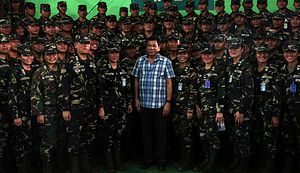Last week, some remarks made by Philippine President Rodrigo Duterte on the country’s potential military acquisitions once again made headlines in local media outlets. Though Duterte’s comments themselves offered little in the way of clarity about the strategic direction the country will take, they did once again put the spotlight on the important question of the future shape of Philippine military modernization under his tenure.
As I have noted before in these pages, though the Armed Forces of the Philippines (AFP) faces a range of internal and external challenges – including insurgencies, natural disasters, and unresolved territorial and sovereignty issues with neighboring states – it spends only around 1 percent of its GDP on defense, which is behind the Southeast Asian average of around over 2 percent of GDP (See: “The Truth About Philippine Military Modernization and the China Threat”).
The Armed Forces Modernization Act, initiated under Duterte’s predecessor Benigno Aquino III in 2013, was an attempt to make up for the anemic (and at times astrategic) investment of the past. Under the plan, Philippine military modernization over the next decade or so was divided into three horizons and phases: the first till the end of 2017; the second from 2018 to 2022; and the third from 2023 to 2028.
Under the First Horizon which started during the Aquino years, where 85 billion pesos was allocated, the Philippines had acquired assets including combat utility and attack helicopters, frigates, armored vehicles, rifles, and cargo and transport aircraft. The Second Horizon, which Duterte said in his budget speech earlier this year would have an amount of 125 billion pesos, was expected to see acquisition of more equipment for external defense missions in the initial list that had been drawn up, including helicopters, fighter aircraft, multi-role fighters, and missile and radar systems.
But since Duterte took office and particularly this year, defense officials had indicated that there would be some changes to the list as well in accordance with the new priorities of the administration and the changing assessment of needs within services, including perhaps more fast crafts and drones capable of addressing transnational threats as well as rifles and other force protection equipment for troops (See: “What’s Next for Philippine Military Modernization Under Duterte?”).
Developments, particularly the siege by Islamic State-linked militants in the southern Philippine city of Marawi that had erupted in May had also reinforced the conception that there could be a shift in the balance between internal and external security considerations that has long been a variable playing into the shape of Philippine military modernization (See: “Battle for Marawi Deepens Philippine Military’s Budget Challenge”).
Though few exact details have been disclosed publicly so far, Duterte already has an idea of what this list looks like, and he has met with economic and defense officials to determine what the major procurement projects will be. And on November 22, during a visit to Philippine Army’s Special Operations Command (SOCOM) in Fort Magsaysay in Nueva Ecija, Duterte disclosed some details about future priorities for Philippine military modernization. In his remarks, which were in a mixture of English and Tagalog and just the latest in a series of off-the-cuff comments we have heard on this score, he mentioned that the Philippine would look to require a list of items including gunship helicopters, multiple rockets, and new firearms.
To be sure, as is often the case, Duterte’s remarks themselves were quite disjointed and in some respects left questions unanswered. For instance, though he referred to several items, he said he was not sure about some of the crucial specifics, such as when exactly they would be delivered and was not really clear on how they would be funded and financed, whether through existing budget allocations, legislative workarounds or loans and other financial agreements with foreign allies and partners (See: “US Terror Aid to Philippines Signals Enduring Defense Ties Under Duterte”).
But some of these items are indeed priorities that could well be approved within the broader list moving forward. For instance, the Philippine Department of National Defense (DND) subsequently clarified that it did indeed planned to acquire 24 new attack helicopters, pending approval of budget for contracting from Duterte as part of the Second Horizon of the RAFPMP. Philippine Budget Secretary Benjamin Diokno had said the acquisition of these helicopters could occur before the end of the year, but he declined to provide more specifics, citing security considerations.
The exact picture of Philippine military modernization over the next few years under Duterte still looks far from clear, and, as noted earlier, tends to be more variable than the fixed in line with evolving priorities and developments. That is important to keep in mind, since we are just in the middle of year two of Duterte’s single, six year term in office, with a number of security issues including two raging insurgencies as well as other domestic agenda items still underdeveloped. As we get closer to 2018 and enter the Second Horizon, it will be interesting to see how things actually eventually shape up, as opposed to just how they are talked about.

































